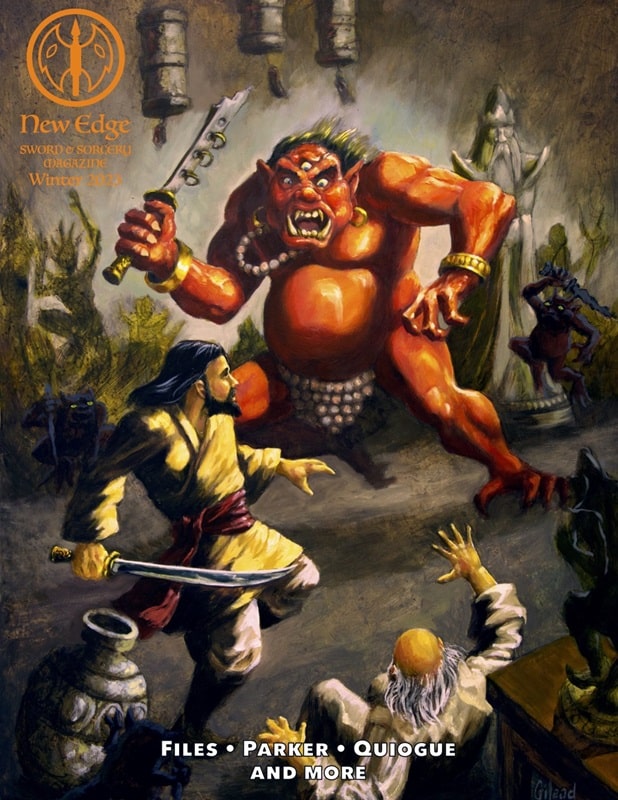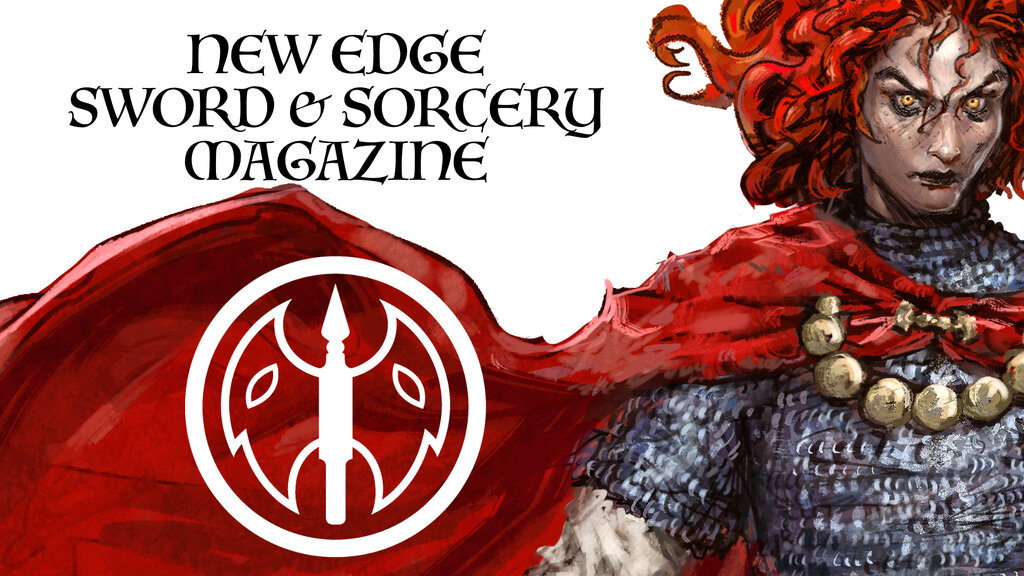A Sword Has Two (New) Edges: A Review of New Edge Sword & Sorcery Magazine, Issue #2
New Edge Sword & Sorcery issue #2,
Winter 2023 (December 8, 2023). Cover by Gilead Artist
The second issue of New Edge Sword and Sorcery has been getting far less attention than its debut, likely because it lacks a story by legendary writer Michael Moorcock, but that’s a shame, as it actually exceeds its predecessor in every demonstrable way. This is editor Oliver Brackenbury’s third time at bat (including the Zero Issue) and he’s clearly getting a feel for how he wants his journal to work. I don’t always agree on the editorial choices of what is included under the NESS banner, but so what? I’m not the editor, and what matters here is that Brackenbury is experimenting and producing.
Let’s get to the goodies.
“The Demon of Tashi Tzang” by Dariel Quiogue
The lead-off story features an alternate Genghis Khan character, Orhan Timur the Snow Leopard, who is a recurring character of Quioge’s whose adventures have appeared in Heroic Fantasy Quarterly, Tales from the Magician’s Skull, and his own stand-alone publication. If you are a fan of Howard Andrew Jone’s alternate Hannibal, Hannuvar, then you know what Quioge is about here, but Timur is Hanuvar’s dark twin. Whereas the former is an aging man, past his prime, now on a final mission bigger than himself, Quioge asks: “What if Genghis’s brother had succeeded in deposing him during his rise to power and he was a hunted man? Would he take that lying down?” Umm, no.
In Tashi Tzang our hero finds himself hiding among a group of pilgrims headed to a remote mountain monastery, which has secrets of its own. It’s a fun siege story, with some great visuals, although the end is a bit clipped. Dariel Quioge is, IMO, one of the absolute best S&S short story writers going right now, and even when one of his stories is only “good” for him, it’s better than most. A strong opening tale.
“Fang” by Jacquie Kawaja
A truly disturbing story that reminds us how closely entwined S&S and horror are. In mood and tone this tale, which is at once a story of undead spirits and retribution, yet also of misunderstanding and the rejection the disabled face for their appearances, is fantastic. As someone with a disability himself, how can I not love the concept? Unfortunately, its shorter length makes the main character’s hobbled legs feel somewhat wedged into the narrative, which begins in media res, as if she were a character we knew from earlier adventures (she isn’t), and it is perhaps the midpoint before it is clear her condition is inherent, not from injury. The end result still works more than it doesn’t, and I found this a truly fresh, unusual tale that bordered just on the shamanistic, but the story fall just short of brilliance.
“Revelstoke” by Gemma Files
I both loved and was deeply frustrated by this Grimdark story, which seems to be setting up a set of recurring characters: a mercenary band in an alternate, late Medieval Europe in which sorcerers exist and are employed by, and against, the Church to aid in combatting magical threats. The Owl, a mysterious mercenary captain, who has been so repeatedly resurrected by the noseless sorceress in his employ that he no longer shows himself outside of his armour (presumably because it isn’t pretty), has been contracted to rescue and transport a blessed pelican back to a bishop. Taking a shortcut through the village of Revelstoke, they find the villagers…changed.
This story abounds with creativity: cool magic, cool characters, interesting ideas. But the world-building trips over itself. We have “Vikings” and Hussites and the Varangian Guard…with no real explanation as to how the former is meant to exist with the latter, despite four centuries of separation, nor the Varangian Guard having long since being extinct in the last days of the rump Byzantine Empire. There may be reasons in the author’s mind, the same way John M. Ford’s brilliant Dragon in Waiting had an alternative 15th century complete with Mithraism and alternate Christianities, but there’s no room in the narrative to explain any of that and it makes the references to the various anachronisms feel jarring and distracting rather than intriguing. That said, I’d love to see more of these characters and their strange world.
“A Debt Forgotten, a Debt Unpaid” by Jeremy Pak Nelson
Another dark tale, almost in the mode of Tanith Lee, about perhaps the last of a race of demigods, kept as a fattened calf (literally) by the ruling empire to be periodically bled into a mercury bath. By some alchemical process, the resulting metal can then be alloyed to create uniquely potent weapons. For 50 years our protagonist has been kept so and at last he finds a means to escape, by using an ancient form of blood and mirror magic to try and invoke one of the banished gods from which his people descend. But a cruel empire does not mean the gods it overthrew were necessarily anymore benevolent. This was a very lush story, literarily, that works perfectly until the last two paragraphs, which just don’t stick the landing. Don’t blink or you’ll miss the resolution, and you may still be left wondering “why” beyond “because it was moody and cool”.
“The Eyes of the Demon” by J.M. Clarke
This is old-school sword & sorcery: the hero hired for a mission, by allies that he doesn’t trust and don’t trust him. Clarke’s Kyembe the Sengezian a “demon-eyed” warrior-mage is a recurring character, and a fun one, who definitely feels like something from the later S&S era of the late 70s, early 80s. The twist is that it is African fantasy…occurring high in the mountains where it can actually *snow*, among a race of semi-giants. Oh, and there is an ice demon who can see in blizzards. Straightforward adventure, well done, and Kyembe is proving to be a lot of fun.
“Water, Which Laughs at All Things” by T.K. Rex & L. Ann Kinyon
An ambitious, literary story, with an environmental plot and alternating PoVs. The Faultlands setting seems intriguing, I enjoyed the “party” of characters, but felt the story tripped over its own cleverness. The internal musings of Okk, the gladiator-turned-poet, which are all in verse, didn’t really advance the story (and frankly, weren’t very good verse), and the villain’s defeat was so convoluted and brief, I had to back and reread it. It involves an elk. Really.
It’s a cute story, that almost felt like a hybrid of cozy and a D&D party, but certainly not what I would call S&S or heroic fantasy.
“Atonement for a Resurrected God” by David C. Smith
David Smith is the “old hand” this issue, a major figure from the 70s boom of S&S, who returns here with Virissa and Edrion his queer warrior pair from issue zero. Smith is creating something like an LGBT Fafhrd and Mouser here, which I felt to be something of a gimmick in their debut story, “Old Moon Over Irukad.” Shame on me for doubting! Here the characters are more settled, and the story can just develop on its own terms. Smith is a living master of the craft; a man who was able to take as thin a character as Red Sonja and (with the late Richard Tierney) write a series of spec novels that were far better than they had any right to be; or were being churned out by most writers in the same era.
“How Many Deaths Till Vengeance?” by June Orchid Parker
Set in a pseudo-classical setting, Astharta spots a wealthy patrician whom she believes to be the man responsible for the murders of her family and sets out for revenge. Straightforward? Yes, but we all know the story of sorcerers who have made themselves difficult to kill through magic, right? This dark, gruesome story will exhaust you as it does our heroine — in just the right way. A great ending to this issue’s fiction.
Non-fiction articles include:
Neurodivergence in Sword & Sorcery by Jonathan Olfert
As the father of a neurodivergent son this short article was an interesting read, though considering the sheer number of neurodivergent readers and authors drawn to this genre, I’m not sure that such characters or concerns are nearly as under-represented in fantasy as they are in literature or many other genres.
Sword & Soul Brothers by Milton J. Davis
A warm, heartfelt reflection on the legendary Charles Saunders by his friend and spiritual heir, Milton Davis. There have been many wonderful tributes to the man, but this one is the one you should read.
Sword & Silk: An Interview with Dariel Quiogue, by Oliver Brackenbury
I criticized the transcribed podcast in Issue 1 for being too long and for the interviewer doing too much of the heavy lifting, but this time, with an interview subject who knows their material and what they want to say, we have no such issues. Sword & Silk is a fun, fast read, filled with some fascinating insights into life as a fantasy and comics fan in Southeast Asia, Dariel’s one-man battle to create a “Sword & Silk” sub-genre, bring back Sword & Planet fiction, and what’s currently on his plate. It’s the tight, dynamic back-and-forth interview that was missing in Issue 1.
Return of the Sorceress by Silvia Moreno-Garcia, a review by Kris Vyas-Myall
A wonderful, Mesoamerican-adjacent novella by the prolific and impossible-to-pin-down Moreno-Garcia that received so little attention because of the high price-tag of a limited edition. Having read this work, its only flaw is that SM-G creates an intriguing world that she is unlikely to revisit.
All-in-all, NESS builds on Issue 1’s strengths and mitigates its weaknesses. Issues 3 and 4 are about to crowdfund on Backerkit, featuring a variety of returning authors and new entries, including the first appearance since 1939 of that original red-headed swordswoman: Jirel of Joiry. Keep your eye out and your sword sharp!

